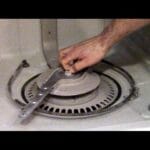Imagine stepping into your basement, only to find an unexpected puddle of water. Your heart sinks as you realize that the culprit might be a leaking toilet from upstairs.
It’s a situation no homeowner wants to face, but understanding what’s happening and knowing how to fix it can save you time, money, and stress. You might be wondering, “How did this happen, and what can I do about it?
” This article will guide you through the causes, solutions, and preventive measures for a toilet leaking into your basement. By the end, you’ll have the knowledge to tackle this problem head-on, ensuring your home stays dry and damage-free. Let’s dive in and make sure your basement remains the safe haven it should be.

Credit: www.youtube.com
Identifying The Leak Source
When you discover water pooling in your basement, it’s easy to panic. A leaking toilet could be the culprit, but pinpointing the exact source of the leak is crucial for a quick fix. Before you call a plumber, you can perform a few checks yourself to save time and money.
Check The Wax Ring
The wax ring is a common suspect when dealing with toilet leaks. Located between the toilet base and the floor, it creates a seal to prevent water from escaping. If you notice water around the toilet base, this could indicate a compromised wax ring.
Have you recently noticed any unpleasant odors around your toilet? A worn-out wax ring often allows sewer gases to escape, causing a foul smell. Consider if your toilet has been wobbly or if you’ve noticed floor discoloration, both of which could suggest a wax ring issue.
Inspect The Water Supply Line
The water supply line connects your home’s plumbing to the toilet tank. Over time, these lines can loosen or become damaged, leading to leaks. Check for any visible water drips or moisture around the connection point.
Have you ever tightened a loose screw and felt the satisfaction of a quick fix? Sometimes, simply tightening the connection can solve the problem. If the line looks worn or cracked, replacing it might be necessary to prevent further leaks.
Examine The Toilet Tank
Leaks can also originate from the toilet tank itself. Carefully lift the lid and inspect the inside for any cracks or water seeping from the tank’s bottom. A faulty flapper or fill valve can also cause water to escape unnoticed.
Are you familiar with that annoying sound of a continuously running toilet? This could be a sign that the internal components are not functioning correctly. Adjusting the float or replacing the flapper can often stop leaks and save water.
Identifying the source of a toilet leak doesn’t have to be daunting. By checking these common areas, you can quickly diagnose and address the issue. Have you experienced a similar problem before? Sharing your experiences can help others tackle their leaks more effectively.

Credit: www.reddit.com
Necessary Tools And Materials
Fixing a toilet leaking into the basement requires essential tools and materials. You’ll need a wrench, plumber’s tape, and a new wax ring. Gather these items to ensure a smooth repair process.
To tackle a toilet leaking into the basement, gather the right tools. These tools simplify the repair process. They ensure efficient work and safety. Understanding the necessary tools and materials is essential. It prevents potential mishaps during the repair.Basic Plumbing Tools
Start with basic plumbing tools. A wrench is crucial for loosening and tightening parts. Use a plunger to clear minor blockages. A plumber’s snake helps reach deeper clogs. A screwdriver assists in removing screws from fixtures. These tools form the backbone of any plumbing task.Replacement Parts
Replacement parts are often required. Wax rings prevent leaks at the base. Flapper valves control water flow in the tank. Bolts and nuts secure the toilet firmly. Supply lines carry water to the tank. Keep these parts handy for quick fixes.Safety Gear
Safety gear protects during repairs. Wear gloves to shield hands from dirt. Safety goggles prevent eye injuries from splashes. A face mask guards against inhaling dust or mold. Knee pads protect when kneeling for long periods. Safety gear ensures a secure repair environment.Fixing The Wax Ring
Toilet leaks into the basement often due to a faulty wax ring. Fixing the wax ring ensures a tight seal. Prevents water from seeping through, protecting your home from water damage.
Fixing the wax ring is crucial for stopping toilet leaks. This small component can cause big problems. A faulty wax ring lets water escape. It can lead to damage in your basement. Fixing it requires a few straightforward steps. Let’s dive into the process.Removing The Toilet
First, shut off the water supply. This step prevents messes. Flush the toilet to empty the tank. Use a sponge to remove remaining water. Disconnect the water line from the tank. Loosen and remove the bolts on the toilet’s base. Carefully lift the toilet off the floor. Place it aside on towels or a blanket. You’ll see the old wax ring.Installing A New Wax Ring
Clean the area around the toilet flange. Remove any old wax and debris. This ensures a snug fit for the new ring. Position the new wax ring on the flange. Ensure it’s centered properly. The wax ring creates a watertight seal. This step is vital to stop leaks.Re-securing The Toilet
Align the toilet over the wax ring. Lower it onto the ring slowly. Apply firm, even pressure. This compresses the wax for a perfect seal. Re-attach the bolts at the base. Tighten them evenly. Reconnect the water supply line. Test for leaks by flushing the toilet. Make sure everything is secure. This completes the process.Repairing The Water Supply Line
A leaking toilet can lead to water seeping into your basement. The water supply line is often the culprit. Fixing this can prevent further damage. Address the issue promptly. Proper repair ensures a leak-free home.
Tightening Connections
Check the connections of your water supply line. Use a wrench to tighten loose connections. Don’t apply too much force. Over-tightening can cause damage. Ensure each fitting is secure. This might stop the leak. Inspect the washers as well. Worn washers need replacement.
Replacing The Supply Line
If tightening doesn’t work, consider replacing the supply line. Turn off the water supply first. Use a wrench to disconnect the old line. Choose a high-quality replacement. Ensure it’s the right size and type. Install the new line securely. Turn the water back on. Check for leaks to ensure success.
Addressing Tank Issues
Addressing tank issues is crucial to prevent toilet leaks into basements. A leaky toilet can cause serious water damage. It often stems from issues within the toilet tank. Fixing these problems ensures a dry and safe basement. Let’s explore two common tank problems. Learn how to fix them easily.
Fixing A Leaky Flush Valve
A leaky flush valve lets water seep from the tank to the bowl. This constant flow can lead to basement leaks. First, turn off the water supply. Then, empty the tank by flushing. Check the flush valve for any debris or damage. If it’s worn out, replace it with a new one. Ensure the new valve fits snugly. Tighten it properly to prevent future leaks. Finally, turn the water back on and test the flush. A successful fix will stop water leaks immediately.
Replacing The Fill Valve
A faulty fill valve can cause overflow, leading to basement leaks. To fix this, start by turning off the water. Drain the tank completely. Remove the old fill valve carefully. Install the new fill valve according to instructions. Make sure it’s securely in place. Adjust the float to the right water level. This prevents overflow and potential leaks. Turn the water supply back on. Test the toilet to ensure the fill valve works correctly.

Credit: www.reddit.com
Preventive Measures
Leaky toilets can lead to basement damage. Regular inspections help spot leaks early. Fixing cracks in pipes and seals prevents costly repairs. Maintaining a dry basement keeps structural integrity intact.
When water starts leaking from your toilet into the basement, it can lead to significant damage and costly repairs. But the good news is that with some preventive measures, you can minimize these risks. By staying proactive, you ensure the safety and longevity of your home’s plumbing system.Regular Maintenance Tips
Regular maintenance is key to keeping your plumbing in top shape. Schedule periodic inspections to check for any signs of wear or damage. A small crack or loose seal can become a major issue if left unattended. Clean your toilet and its components regularly. This prevents the build-up of minerals and grime that can lead to leaks. Ensure that all parts, especially the flapper and fill valve, are functioning correctly. You might be surprised how much a simple task, like tightening loose bolts, can prevent future leaks. Have you ever noticed water pooling around the toilet base? That might be a sign your bolts need tightening.Signs Of Future Leaks
Identifying potential leaks before they occur can save you a lot of trouble. Look out for discoloration or water stains on the ceiling below your bathroom. This is often an early warning sign of a leak from above. Do you notice a persistent musty smell in the basement? That could indicate hidden moisture or mold caused by a slow leak. Keep an ear out for unusual sounds. If you hear water running when no one is using the bathroom, it might be a sign of a leak. Lastly, test your water pressure. Low pressure can indicate a leak somewhere in your system. Addressing these issues early can prevent more serious damage later on. Taking preventive measures isn’t just about maintaining your home—it’s about peace of mind. What steps will you take today to protect your home from leaks?When To Call A Professional
Toilet leaks can be tricky to handle alone. Identifying the right time to call a professional is essential. DIY attempts might not always solve the problem. Sometimes, expert help ensures a complete fix.
Complex Leak Situations
Some leaks are not easy to spot. Water might be seeping through hidden areas. Professionals have the tools to detect such leaks. They can find and fix problems you might miss. Complex issues need expert attention to prevent further damage. Ignoring them can lead to bigger repairs.
Cost Versus Diy
DIY repairs might seem cheaper at first. But they can cost more if mistakes happen. Hiring a professional ensures the job is done correctly. It saves money in the long run. A professional can also provide a warranty for their work. Peace of mind is worth the extra cost.
Frequently Asked Questions
Why Is My Toilet Leaking Into The Basement?
A broken wax seal can cause leaks. Also, cracks in pipes or connections might be the issue.
How Can I Identify The Leak Source?
Check for wet spots or water stains. Listen for dripping sounds. Inspect pipes and seals closely.
What Should I Do If My Toilet Leaks?
Turn off the water supply. Then, call a plumber. Quick action prevents further damage.
Can I Fix The Leak Myself?
Yes, if it’s simple like a loose connection. For complex issues, hiring a professional is best.
How Can I Prevent Future Leaks?
Regularly check seals and connections. Avoid flushing non-flushable items. Proper maintenance helps prevent issues.
Conclusion
Fixing a toilet leak into the basement is crucial. It prevents further damage. Address leaks promptly to save money and time. Regular checks help avoid costly repairs. Ensure proper sealing and maintenance. Don’t ignore small drips; they worsen over time.
Seek professional help if needed. A dry basement means a healthier home. Protect your investment by staying proactive. Simple steps can prevent major issues. Keep an eye on your plumbing. Your home will thank you for it. Stay vigilant and attentive.
Your efforts will pay off.




